Costa Rica |
||||||||||||||||||||||||
|
Click the points on the map to learn more.
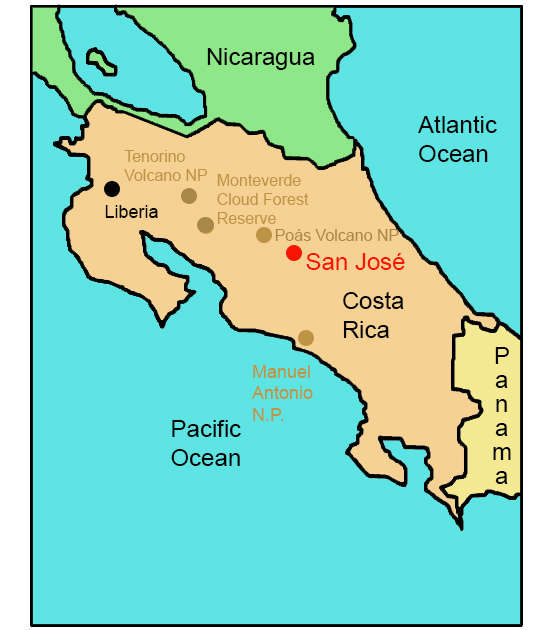
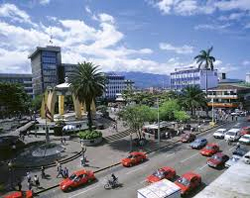 |
San JoséSan José is the capital and largest city in Costa Rica. Settled in 1736, the city grew to be a tobacco center in the Spanish colonial era, and in 1823 in became Costa Rica’s capital. San José is now a hub of transportation (as a point on the Inter-American Highway), politics, and economics in Costa Rica. With a population of over 288,000, it is the largest city in Costa Rica. |
| Back to Map | |
 |
LiberiaLiberia is the rural capital of the Guanacaste province, and serves as a transportation hub connecting Costa Rica with Nicaragua. Most of the city's residents are involved in ranching operations. Liberia, nicknamed the "white city," for its white gravel roads and buildings, has become a major center for the country’s tourism industry. |
| Back to Map | |
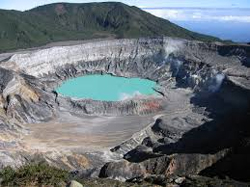 |
Poás Volcano National ParkPoás Volcano is one of Costa Rica’s most active volcanoes. It rises more than 8,000 feet above sea level with frequent displays of small geyser and lava eruptions. The last major eruptions from Poás were from 1952-1954. today, tourists enjoy driver near the top of the volcano to view the colorful summit craters. The park, however, is often closed because of dangerous sulfuric gas emissions. |
| Back to Map | |
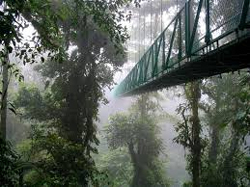 |
Monteverde Cloud Forest ReserveMonteverde is a small village in mountainous northwestern Costa Rica, located along the continental divide. Because of its high altitude, it is well known for its cloud forests and biodiversity. Today, an area of more that 40 square miles is protected as the Monteverde Cloud Forest Preserve. It is home to over 2,500 species of plants, 400 species of birds, and 100 species of mammals including 58 species of bats. |
| Back to Map | |
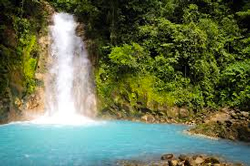 |
Tenorino Volcano National ParkThe 6,267 foot-tall Tenorino Volcano consists of four volcanoes and two craters and is the centerpiece of the national park. The park also features Río Celeste, which winds through the park's rainforest. The river is notable for its vibrant blue water. Scientists have found that the rocks at the bottom of the river have a mineral coating that includes silicon, oxygen, and aluminum which reflects and scatters sunlight. The result is actually an illusion of deep blue perceived by the human eye. |
| Back to Map | |
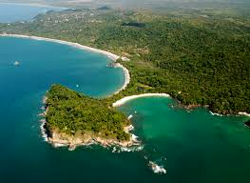 |
Manuel Antonio National ParkParque Nacional Manuel Antonio is located on Costa Rica’s Pacific coast. Here, white sand beaches meet evergreen forest at the ocean’s high tide line. The rest of the park is covered by forest, mangrove swamps, lagoons and beach vegetation. There are 109 species of mammals and 184 species of birds within the park. Tourists can find tours for zip lining, whitewater rafting, snorkeling, fishing, and more inside. Although it is the smallest national park in Costa Rica, Forbes Magazine recently rated it as one of the world's twelve most beautiful national parks.
|
| Back to Map | |
| Population: | 4,872,000 million |
| Area: | 19,730 square miles |
| Capital City: | San José |
| Largest City: | San José |
| Currency: | Costa Rican Colón |
| Official Language: | Spanish |
| GDP (Gross Domestic Product) | $49.6 billion |
- Costa Rica’s terrain includes rugged mountains made up of over 100 volcanic cones
- A quarter of Costa Rica’s land has ‘protected’ status
- Pura vida, or “simple life,” is not only Costa Rican’s favorite phrase to say hello, goodbye, and ‘it’s all good,’ but also a way of life for native Costa Ricans
- The Quetzal is Costa Rica’s national bird
- In 1949, Costa Rica dissolved its armed forces. It is now the only country in the Western Hemisphere without any national defense
- Costa Rica plans to become a carbon-neutral country by 2021. This means any carbon emissions will be offset by measures to create renewable energy, or, by planting trees and taking other measures to absorb carbon emissions.
- Volcán Arenal, the nation’s most active volcano, last erupted in 2010
- Over 50% of Costa Rica’s land is covered by forest
- In 2012, Costa Rica became the first nation to ban recreational hunting
- Costa Rica means “rich coast” in Spanish
|
|
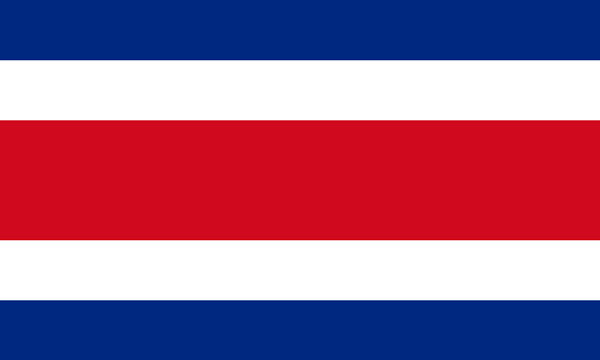 |
|
The blue stripes stand for the sky, opportunity, and perseverance. White represents peace, happiness, and wisdom. Red stands for the blood shed for freedom, as well as the vibrancy and generosity of the Costa Rican people. |
|